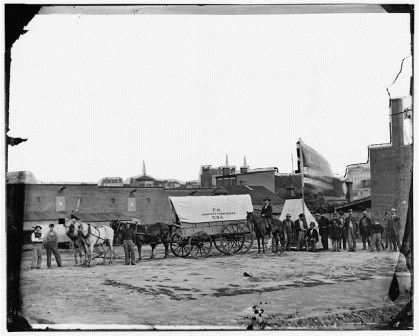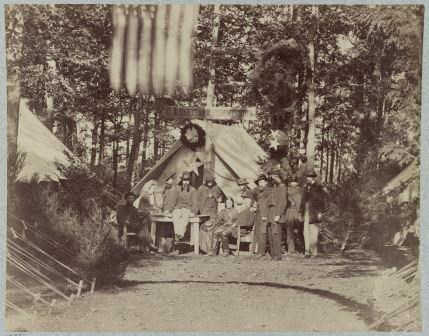|
Interested in diving deeper into the Olmsted connection to the Civil War? Check out Women's Work: Olmsted and the Women of the United States Sanitary Commission.

Library of Congress, Prints and Photographs Division, Civil War Photographs, [LC-DIG-CWPB-04159]
Origins of the USSC The United States Sanitary Commission (USSC) grew out of the Women's Central Association of Relief and the ideas of Rev. Henry Bellows, a Unitarian minister. Bellows envisioned a centralized organization which would incorporate local aid societies scattered throughout the North. On 13 June 1861, President Lincoln signed an executive order to establish Bellow's organization. With the USSC formally established, Bellows sought a competent leader with proven administrative experience overseeing large, civilian-based enterprises; his search lead him directly to Frederick Law Olmsted. 
Library of Congress, Prints and Photographs Division, Civil War Photographs, [LC-DIG-PPMSCA-33752] Olmsted proved a superb candidate for the General Secretary of the USSC. His success in designing New York City's Central Park, one of the largest public works projects of the antebellum era, earned him a national reputation, not only as a landscape architect but also as an administrator. Olmsted readily accepted the offer to head the USSC in 1861. As wounded soldiers streamed into USSC hospitals by the hundreds during the Peninsula Campaign of 1862, Olmsted rose to the challenge. His responsibilities included supervising medical staff, distributing supplies, and personally treating soldiers who suffered from battlefield wounds. By the close of the campaign, which ended in Union retreat, Olmsted estimated that the USSC treated upwards of 8,000 sick and wounded soldiers. Eventually, physical and mental exhaustion compelled Olmsted to resign as General Secretary on September 1, 1863. Olmsted's Impact
Thanks to Olmsted's impressive administrative and leadership skills, the USSC successfully aided thousands of soldiers. Using the same logical, analytical approach he applied while managing the Central Park project, Olmsted developed a series of procedures and protocols that enhanced USSC operations.
By the war's end, the USSC, in addition to treating many thousands of wounded soldiers, worked with 286 local aid societies, from which it obtained millions of dollars in supplies and donations. Furthermore, the Commission conducted 1,482 camp inspections, advised army medical staff, and established a veterans' bureau to aid returning soldiers. The USSC was a remarkable achievement—one that gave Olmsted great pride and satisfaction.
.
|
Last updated: March 1, 2024
